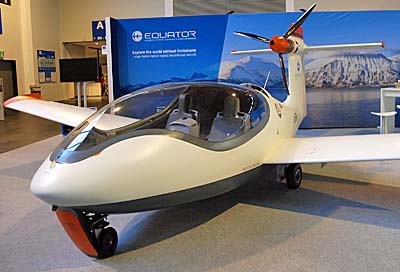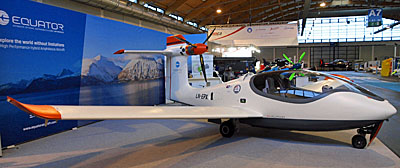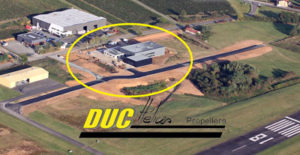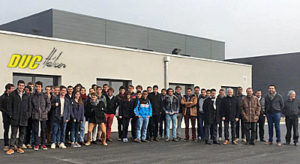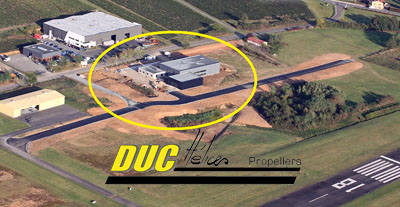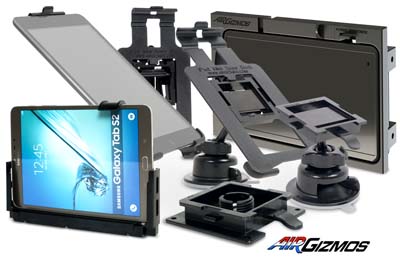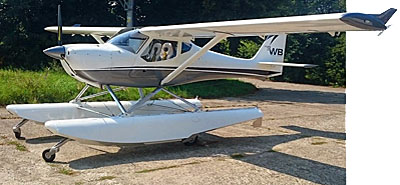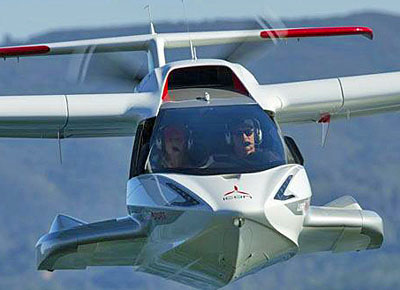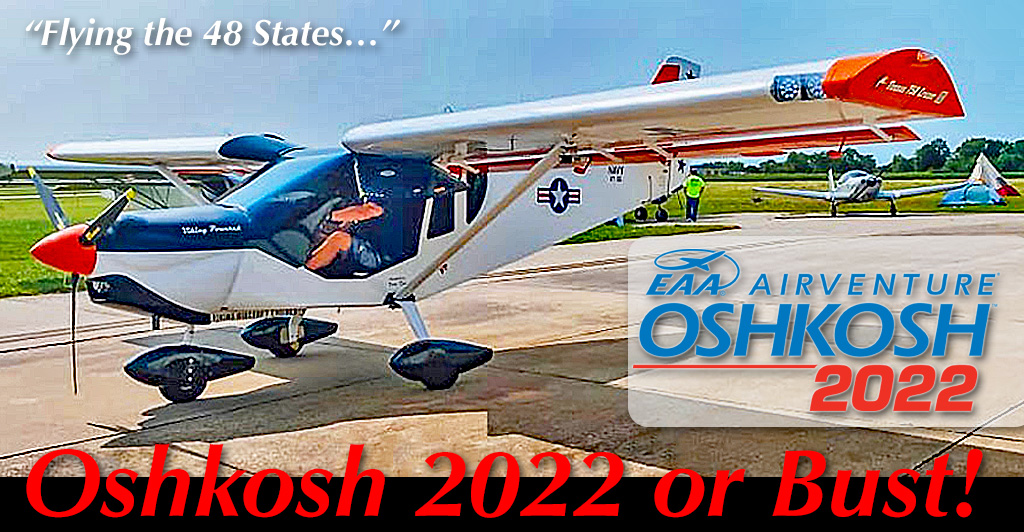
“Time to spare? Go by air!” is a familiar humor line, speaking to weather uncertainties, mechanical delays, or relaxed cruise speeds that can slow or stall a cross-country flight in our fun, recreational aircraft. One man created his own special way to log some flight hours getting to Oshkosh. Evidently this adventurous pilot never heard another popular line: “The shortest distance between two points is a straight line.” (Don’t anyone challenge me with Great Circle routes; this is about a long flight but not a globe-spanning one.) While pilots around the nation are in various stages of preparation for the flight to EAA’s big summer celebration of flight, our aerial explorer is already en route. He’s about halfway as this is posted. Ambitious Journey I’ve had the pleasure to fly into Oshkosh a number of times. I’ve also several times flown with pilots making their first entry. Ask anyone who’s done it; joining the arrival pattern to Oshkosh on the busy days right before it opens is an experience no one forgets.


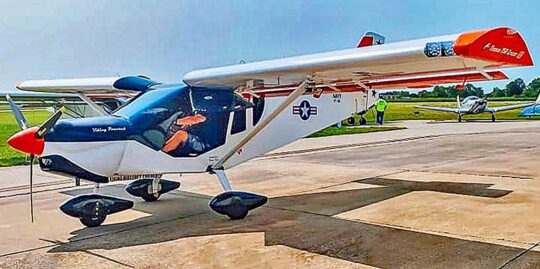 One man created his own special way to log some flight hours getting to Oshkosh. Evidently this adventurous pilot never heard another popular line: "The shortest distance between two points is a straight line." (Don't anyone challenge me with Great Circle routes; this is about a long flight but not a globe-spanning one.)
While pilots around the nation are in various stages of preparation for the flight to EAA's big summer celebration of flight, our aerial explorer is already en route. He's about halfway as this is posted.
One man created his own special way to log some flight hours getting to Oshkosh. Evidently this adventurous pilot never heard another popular line: "The shortest distance between two points is a straight line." (Don't anyone challenge me with Great Circle routes; this is about a long flight but not a globe-spanning one.)
While pilots around the nation are in various stages of preparation for the flight to EAA's big summer celebration of flight, our aerial explorer is already en route. He's about halfway as this is posted.
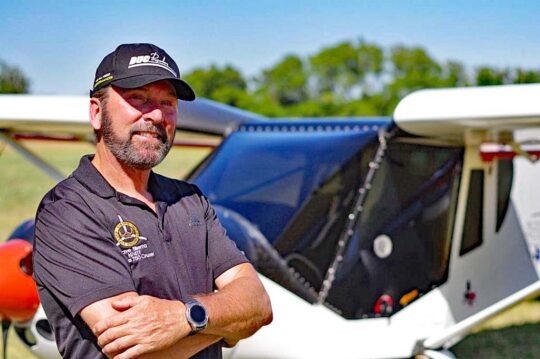 That's still not enough for our Zenith aviator — but arriving KOSH will definitely be the icing on his cake, so to say.
Let's meet him.
Dave Tillema of Southeast Texas has embarked on an ambitious journey in an aircraft he built himself: his
That's still not enough for our Zenith aviator — but arriving KOSH will definitely be the icing on his cake, so to say.
Let's meet him.
Dave Tillema of Southeast Texas has embarked on an ambitious journey in an aircraft he built himself: his 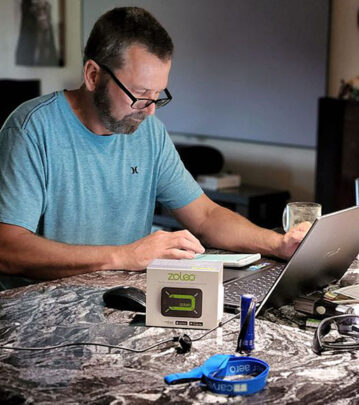 "I wish I could have tried this before everything got so expensive, but the stars didn't align," explained Dave. He's underway now, though. "This will be an all or nothing attempt: Oshkosh or Bust!"
However, he observed, "With costs skyrocketing into the absurd, I'm reaching out to fellow aviation enthusiasts. If y'all can help, I'd appreciate it very much." It was interesting to see comments on
"I wish I could have tried this before everything got so expensive, but the stars didn't align," explained Dave. He's underway now, though. "This will be an all or nothing attempt: Oshkosh or Bust!"
However, he observed, "With costs skyrocketing into the absurd, I'm reaching out to fellow aviation enthusiasts. If y'all can help, I'd appreciate it very much." It was interesting to see comments on  "I would definitely appreciate any hospitality, accommodations and/or fuel along the journey. My final stop each day will be determined by weather mostly, so planning for the trip is going to be day by day."
Dave's Zenith CH 750 Cruzer is powered by a Honda-based 130-horsepower powerplant from
"I would definitely appreciate any hospitality, accommodations and/or fuel along the journey. My final stop each day will be determined by weather mostly, so planning for the trip is going to be day by day."
Dave's Zenith CH 750 Cruzer is powered by a Honda-based 130-horsepower powerplant from 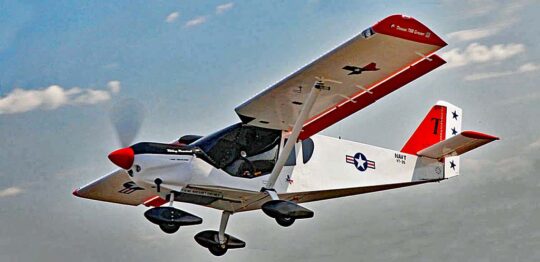 Dave said his Cruzer is "very inexpensive to fly and very quick to build. It's a great combination."
The Oshkosh 48-state flight is not the only effort Dave has given to share his love of flying with others. Before starting the Oshkosh flight, he'd flown 99 passengers in his Cruzer. He's logged nearly 800 hours in his airplane in less than three years.
One of the best ways to follow Dave 48-state adventure is on his
Dave said his Cruzer is "very inexpensive to fly and very quick to build. It's a great combination."
The Oshkosh 48-state flight is not the only effort Dave has given to share his love of flying with others. Before starting the Oshkosh flight, he'd flown 99 passengers in his Cruzer. He's logged nearly 800 hours in his airplane in less than three years.
One of the best ways to follow Dave 48-state adventure is on his 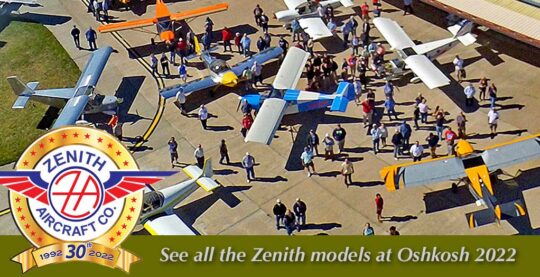
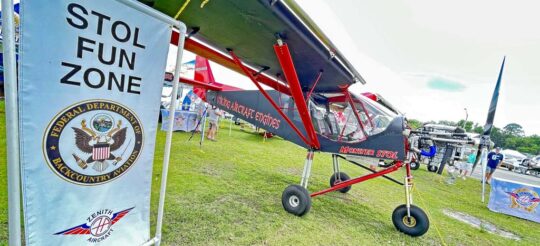 On pleasant evenings, crowds can be five deep all along the runway fence. STOL comps provide exciting close-up action. At few other airports can you observe so closely, literally 100 feet away from runway centerline.
After the main afternoon airshow aerobatic acts conclude, you can do one of two things. You can go to the car park and wait in long lines to get out of the lot or you can make your way to the Ultralight Area / Lightplane Area / or Paradise City and catch the evening STOL comps. When they're done competing, the car parks are moving better and you'll waste less time sitting in line.
STOL comps were planned every evening of Sun 'n Fun but 20 mile per hour winds blowing 90° cross to the runway over a nearby line of tress was a bit much for many competitors. For two days, we've had limited flying in Paradise City.
On pleasant evenings, crowds can be five deep all along the runway fence. STOL comps provide exciting close-up action. At few other airports can you observe so closely, literally 100 feet away from runway centerline.
After the main afternoon airshow aerobatic acts conclude, you can do one of two things. You can go to the car park and wait in long lines to get out of the lot or you can make your way to the Ultralight Area / Lightplane Area / or Paradise City and catch the evening STOL comps. When they're done competing, the car parks are moving better and you'll waste less time sitting in line.
STOL comps were planned every evening of Sun 'n Fun but 20 mile per hour winds blowing 90° cross to the runway over a nearby line of tress was a bit much for many competitors. For two days, we've had limited flying in Paradise City.
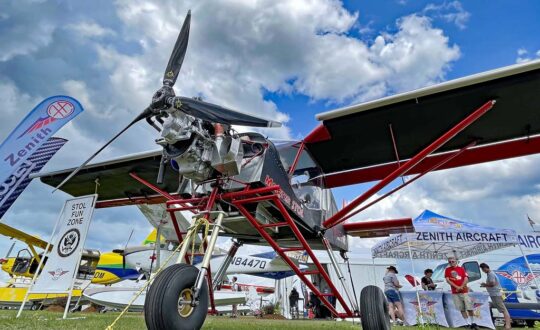 Unfortunately Steve broke an axle and ended up on his nose in Wednesdays gusty conditions. Damage was reasonably minor — an advantage of landing so slowly perhaps — and he should be back in action soon.
His is not the only aircraft designed specifically to win STOL comps.
Unfortunately Steve broke an axle and ended up on his nose in Wednesdays gusty conditions. Damage was reasonably minor — an advantage of landing so slowly perhaps — and he should be back in action soon.
His is not the only aircraft designed specifically to win STOL comps.
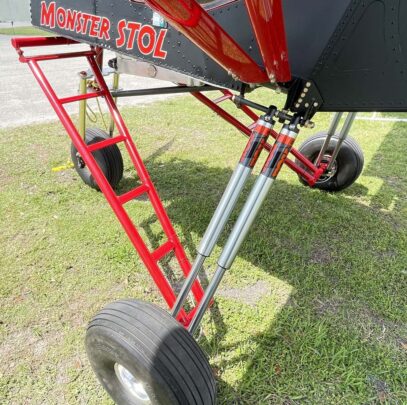
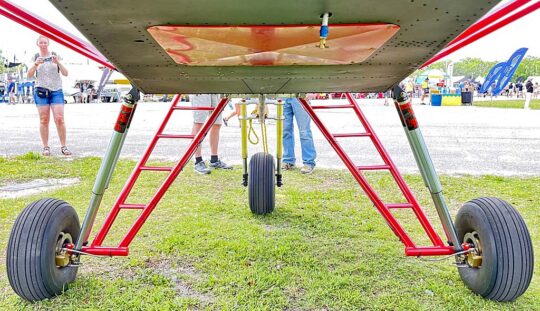 Monster STOL solves that problem, Jan believes. His dual aft shocks on each side have 18 inches of stroke. The tires aren't tundra but they're large. And standing Super Duty up on specialized landing gear — which also helps entry into this high-off-the-ground airplane — allows Jan to create a very steep angle of attack.
"I already get off the surface in 44 feet," said Jan in a video interview you'll see later. He wants to do even better and to further shorten his landings. The super beefy gear arrangement will let him plop the aircraft on the ground in the shortest possible distance.
"It's fun and a little whacky," said Sebastien Heintz of
Monster STOL solves that problem, Jan believes. His dual aft shocks on each side have 18 inches of stroke. The tires aren't tundra but they're large. And standing Super Duty up on specialized landing gear — which also helps entry into this high-off-the-ground airplane — allows Jan to create a very steep angle of attack.
"I already get off the surface in 44 feet," said Jan in a video interview you'll see later. He wants to do even better and to further shorten his landings. The super beefy gear arrangement will let him plop the aircraft on the ground in the shortest possible distance.
"It's fun and a little whacky," said Sebastien Heintz of 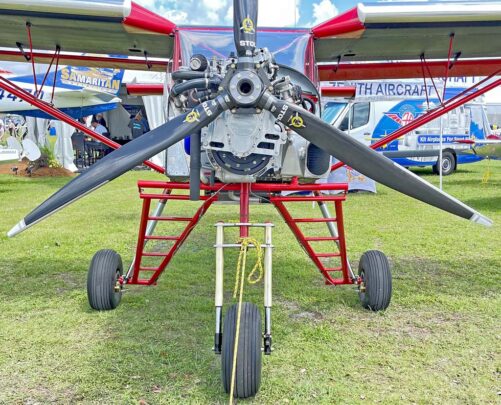
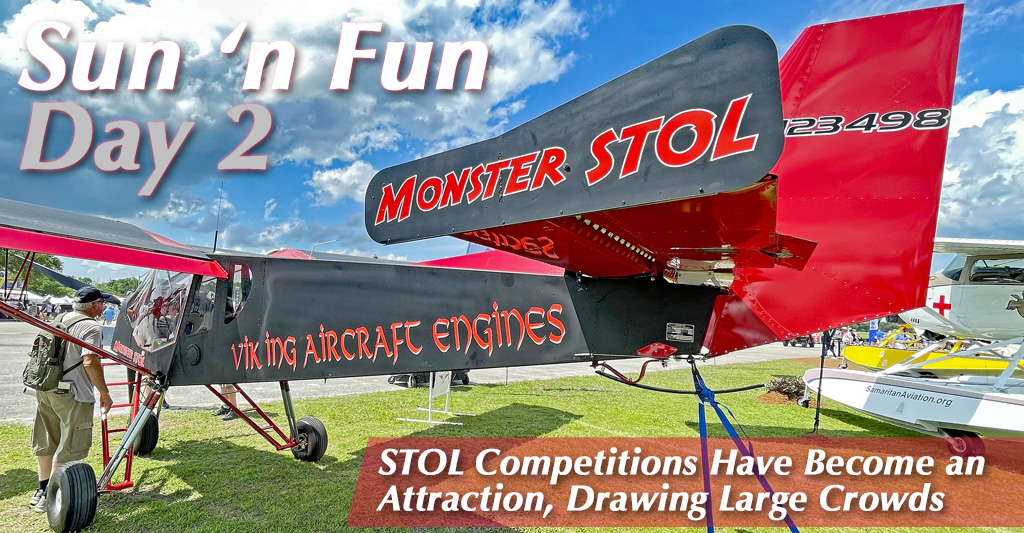
 Rather loudly and persistently I beat the drum about "affordable aircraft," but readers also enjoy learning about other aircraft. I will never write about jets or multimillion-dollar turbines but I will continue to follow any "light" aircraft that meets LSA parameters now or after the Mosaic rule.
In this article I will describe how two aircraft are pursuing conventional certification: Flight Design’s F2-CS23 and Icon’s A5.
Rather loudly and persistently I beat the drum about "affordable aircraft," but readers also enjoy learning about other aircraft. I will never write about jets or multimillion-dollar turbines but I will continue to follow any "light" aircraft that meets LSA parameters now or after the Mosaic rule.
In this article I will describe how two aircraft are pursuing conventional certification: Flight Design’s F2-CS23 and Icon’s A5.
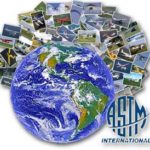 Contrary to common language, LSA are not "certified." Instead a manufacturer declares they meet ASTM standards and FAA "accepts" that declaration. Frequently at first, FAA audited producers in a point-by-point check of their declaration plus verifying that producers use generally-accepted best practices in their manufacturing. Companies with prior approvals may not be required to undergo an audit; it's always FAA's choice.
I've been involved with ASTM for many years and I can attest to these standards being very rigorous. They were welcomed by many countries where they are in active use. Indeed, FAA is using ASTM standards for LSA as a model for a future approval system for Part 23 general aviation aircraft. Nonetheless, a Standard Certificate is required for some countries; LSA have a Special Certificate. So, some companies believe it is in their best interest to obtain the higher level of approval.
Contrary to common language, LSA are not "certified." Instead a manufacturer declares they meet ASTM standards and FAA "accepts" that declaration. Frequently at first, FAA audited producers in a point-by-point check of their declaration plus verifying that producers use generally-accepted best practices in their manufacturing. Companies with prior approvals may not be required to undergo an audit; it's always FAA's choice.
I've been involved with ASTM for many years and I can attest to these standards being very rigorous. They were welcomed by many countries where they are in active use. Indeed, FAA is using ASTM standards for LSA as a model for a future approval system for Part 23 general aviation aircraft. Nonetheless, a Standard Certificate is required for some countries; LSA have a Special Certificate. So, some companies believe it is in their best interest to obtain the higher level of approval.
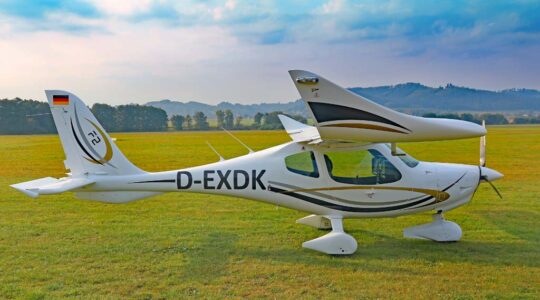 “We couldn’t be happier to see this important step for the F2 program, which ultimately will lead to the F4 four-seat version and the all-electric F2e,” said Matthias Betsch, Head of Flight Design's Design Organization department that created the F-Series and many of its advanced concepts.
"The F2-CS23 is the next step in Flight Design’s ‘Vision Zero’ concept which incorporates all commercially available safety features appropriate for this type of aircraft," the company elaborated. "These features include: a passive stall and spin resistant airframe design; airframe emergency parachute system; Amsafe-brand airbags and inertial reel harnesses; Garmin ESP (electronic stability and envelope protection); a strong occupant-protective enclosure for the pilot and passengers; automatic fuel management; simplified controls such as a combined throttle and brake lever; and a more modern, car-like atmosphere and operation."
“We couldn’t be happier to see this important step for the F2 program, which ultimately will lead to the F4 four-seat version and the all-electric F2e,” said Matthias Betsch, Head of Flight Design's Design Organization department that created the F-Series and many of its advanced concepts.
"The F2-CS23 is the next step in Flight Design’s ‘Vision Zero’ concept which incorporates all commercially available safety features appropriate for this type of aircraft," the company elaborated. "These features include: a passive stall and spin resistant airframe design; airframe emergency parachute system; Amsafe-brand airbags and inertial reel harnesses; Garmin ESP (electronic stability and envelope protection); a strong occupant-protective enclosure for the pilot and passengers; automatic fuel management; simplified controls such as a combined throttle and brake lever; and a more modern, car-like atmosphere and operation."
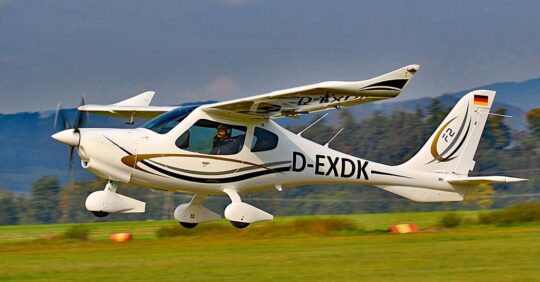
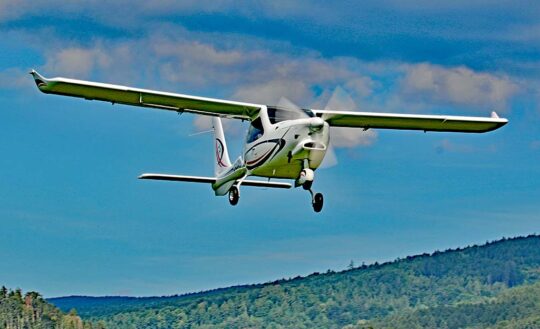 “EASA's CS-23 category is an internationally-recognized certification standard which will allow the new F2-CS23 to be easily accepted in all markets worldwide,” said Dieter Koehler, Project Manager the F2 and F4 projects.
Flight Design sees the F2-CS23 as "an excellent choice for flight schools with its wide and easy-to-enter cockpit, fuel efficiency, unique safety features, and state-of-the-art avionics suite. All new Flight Design aircraft come with carbon compensation up to TBO under Flight Design’s Pro-Climate plan." F2-CS23 follows the company's F2-LSA that began deliveries earlier in 2021.
“EASA's CS-23 category is an internationally-recognized certification standard which will allow the new F2-CS23 to be easily accepted in all markets worldwide,” said Dieter Koehler, Project Manager the F2 and F4 projects.
Flight Design sees the F2-CS23 as "an excellent choice for flight schools with its wide and easy-to-enter cockpit, fuel efficiency, unique safety features, and state-of-the-art avionics suite. All new Flight Design aircraft come with carbon compensation up to TBO under Flight Design’s Pro-Climate plan." F2-CS23 follows the company's F2-LSA that began deliveries earlier in 2021.
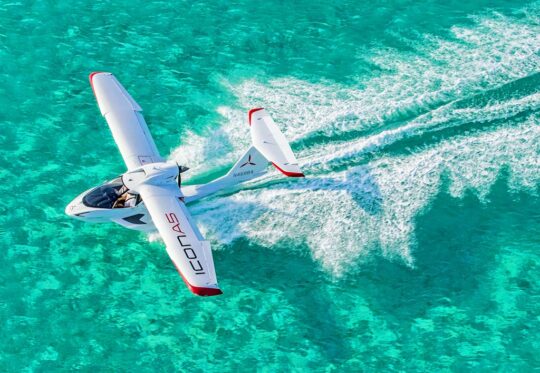 "In countries that do not have a Light-Sport category (Canada and others), the Type Certified version of the
"In countries that do not have a Light-Sport category (Canada and others), the Type Certified version of the 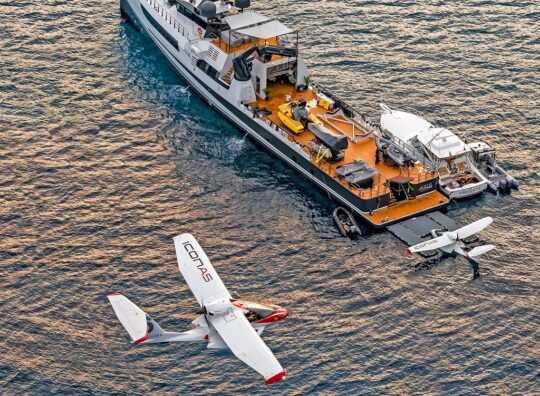 Primary Category certification also has benefits in the U.S., Icon reported. One is that any A&P is authorized to work on it. Because it is not a SLSA, owners will not need to use designated Icon Service Partners, though the company will still encourage them to do so.
Another benefit is international travel, for example, flying your Icon A5 to islands in the Caribbean, or to keep your A5 on a yacht when you are in another country (image). "Light-Sport Aircraft do not receive a Type Certificate," Icon explained, "so typically, special permission is required before you can fly in another country just like if you are flying an Experimental aircraft." Some exceptions exist, notably in the Bahamas, which does allow U.S.-registered LSAs. The Bahamas is further unique among other countries in that they accept FAA's Sport Pilot certificate.
Primary Category certification also has benefits in the U.S., Icon reported. One is that any A&P is authorized to work on it. Because it is not a SLSA, owners will not need to use designated Icon Service Partners, though the company will still encourage them to do so.
Another benefit is international travel, for example, flying your Icon A5 to islands in the Caribbean, or to keep your A5 on a yacht when you are in another country (image). "Light-Sport Aircraft do not receive a Type Certificate," Icon explained, "so typically, special permission is required before you can fly in another country just like if you are flying an Experimental aircraft." Some exceptions exist, notably in the Bahamas, which does allow U.S.-registered LSAs. The Bahamas is further unique among other countries in that they accept FAA's Sport Pilot certificate.
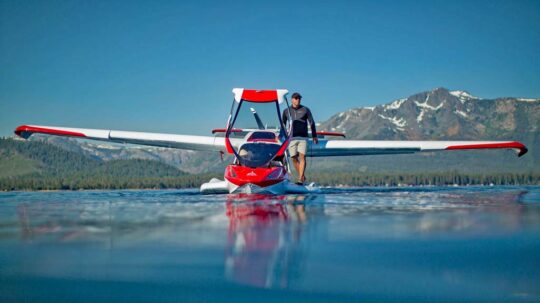 "International expansion has been a critical part of our business plan since day one,” said Jason Huang, President of Icon Aircraft. “People in the U.S. have been able to enjoy adventure flying in the Icon A5 for several years, and we will continue to produce the SLSA version. But now we are excited to introduce the A5 to others around the world. Type Certification is one of the many investments Icon has made to grow our capabilities and improve the A5. We know it will be appreciated by our international deposit holders and sales partners, and we are all very excited for this day to come."
"International expansion has been a critical part of our business plan since day one,” said Jason Huang, President of Icon Aircraft. “People in the U.S. have been able to enjoy adventure flying in the Icon A5 for several years, and we will continue to produce the SLSA version. But now we are excited to introduce the A5 to others around the world. Type Certification is one of the many investments Icon has made to grow our capabilities and improve the A5. We know it will be appreciated by our international deposit holders and sales partners, and we are all very excited for this day to come."
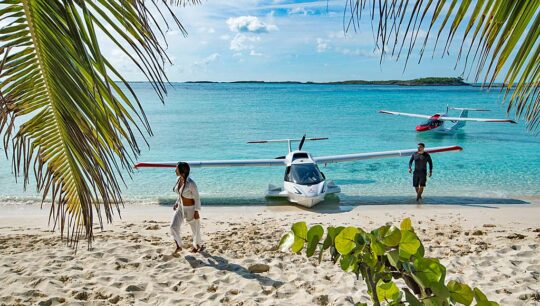 "Note that we will continue to make the SLSA version, as well," assured Huang. This continues the chance for American pilots to fly A5 without the need for an aviation medical, using only their driver's license in lieu of a medical approval.
Why not pursue approval using the coming regulation often referred to as Mosaic?
"Mosaic is an FAA initiative that doesn’t translate globally," stated the company. "Thus, pursuing Primary Category Certification is the action we needed to coincide with our global expansion plans."
"Note that we will continue to make the SLSA version, as well," assured Huang. This continues the chance for American pilots to fly A5 without the need for an aviation medical, using only their driver's license in lieu of a medical approval.
Why not pursue approval using the coming regulation often referred to as Mosaic?
"Mosaic is an FAA initiative that doesn’t translate globally," stated the company. "Thus, pursuing Primary Category Certification is the action we needed to coincide with our global expansion plans."
 https://youtu.be/dxpFU7UfsQo
https://youtu.be/4kBRY79lw5Y
https://youtu.be/dxpFU7UfsQo
https://youtu.be/4kBRY79lw5Y
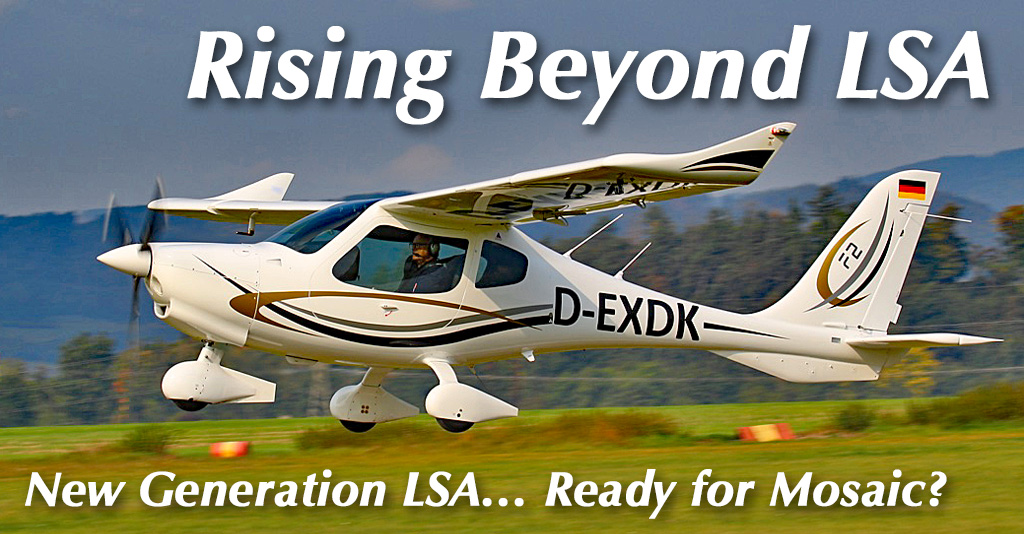
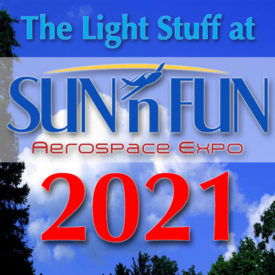 We continue with further coverage from the first major airshow in almost two years… THANKS to
We continue with further coverage from the first major airshow in almost two years… THANKS to 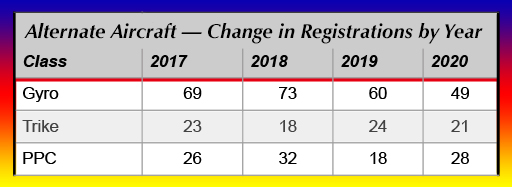 Counting all types, the "alternative aircraft" sector may account for a quarter or more of all LSA sales. Alternative aircraft have attributes that drive customer inquiries: better affordability and unique flying qualities.
Not interested in alternative aircraft? That's hardly surprising as most American pilots were trained in conventional, three-axis, tractor-engined aircraft, usually with a control wheel and rudder pedals. Most of those pilots will stick with a familiar configuration and therefore the LSA market caters to that large pilot community. Others yearn for something different or something more affordable.
Counting all types, the "alternative aircraft" sector may account for a quarter or more of all LSA sales. Alternative aircraft have attributes that drive customer inquiries: better affordability and unique flying qualities.
Not interested in alternative aircraft? That's hardly surprising as most American pilots were trained in conventional, three-axis, tractor-engined aircraft, usually with a control wheel and rudder pedals. Most of those pilots will stick with a familiar configuration and therefore the LSA market caters to that large pilot community. Others yearn for something different or something more affordable.
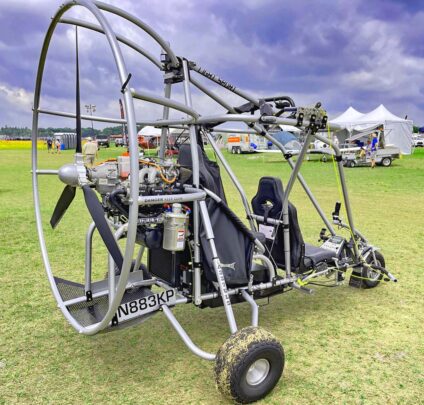 Powrachute Powerhouse
Powrachute Powerhouse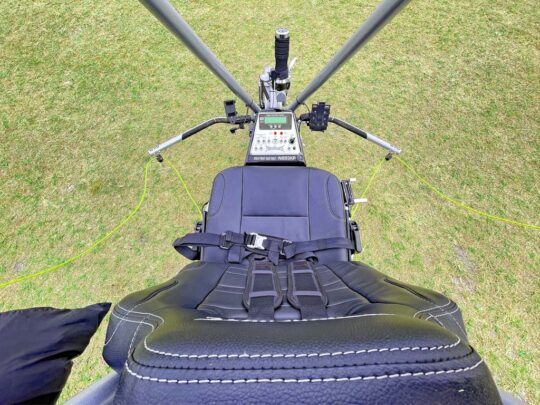
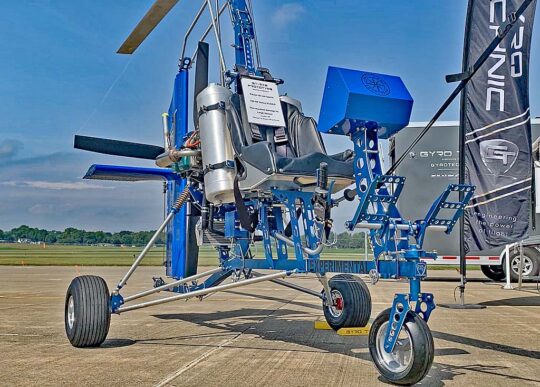 While the idea may have been invented many years ago in the USA, Europeans adopted the type in the 2000s and took the idea further. They also worked out flight characteristics to make these contemporary machines easier to fly. My experience with them (see this
While the idea may have been invented many years ago in the USA, Europeans adopted the type in the 2000s and took the idea further. They also worked out flight characteristics to make these contemporary machines easier to fly. My experience with them (see this 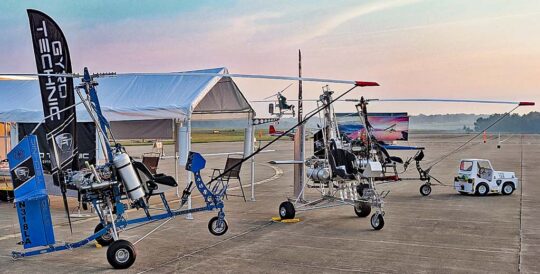 Those older American gyroplanes — think: Bensen Gyrocopter — were nearly all single seaters. Maybe that was best then, when stability was different than today. Then I discovered the VX1 at the Midwest LSA Expo. Hmmm, a modern gyroplane with all the present-day knowledge but in single seat form. Intriguing. It doesn't look like other modern gyros and the video below will explain.
Lots of buyers want a second seat for a friend or their spouse yet more often than not aircraft are flown solo. A single seat aircraft has some advantages and the pilot can merely enjoy him or herself without have to assure their passenger is comfortable. Single seaters can also cost less partly because they don't need as much engine.
Combine these attributes with some of the finest, beautifully-accented machine work you'll ever see and Gyro Technic truly has something in their VX1. Finally, the Minnesota company is rare in that it also makes its own rotor blades and can supply other producers.
Those older American gyroplanes — think: Bensen Gyrocopter — were nearly all single seaters. Maybe that was best then, when stability was different than today. Then I discovered the VX1 at the Midwest LSA Expo. Hmmm, a modern gyroplane with all the present-day knowledge but in single seat form. Intriguing. It doesn't look like other modern gyros and the video below will explain.
Lots of buyers want a second seat for a friend or their spouse yet more often than not aircraft are flown solo. A single seat aircraft has some advantages and the pilot can merely enjoy him or herself without have to assure their passenger is comfortable. Single seaters can also cost less partly because they don't need as much engine.
Combine these attributes with some of the finest, beautifully-accented machine work you'll ever see and Gyro Technic truly has something in their VX1. Finally, the Minnesota company is rare in that it also makes its own rotor blades and can supply other producers.
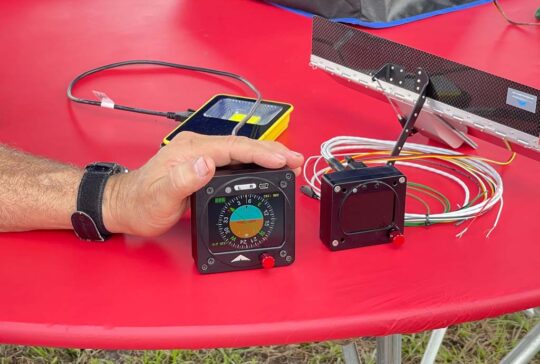 Levil Aviation greatly empowered the role of tablets in the cockpit today by pioneering the first iPad-compatible wireless avionics suite in 2009. Today's
Levil Aviation greatly empowered the role of tablets in the cockpit today by pioneering the first iPad-compatible wireless avionics suite in 2009. Today's 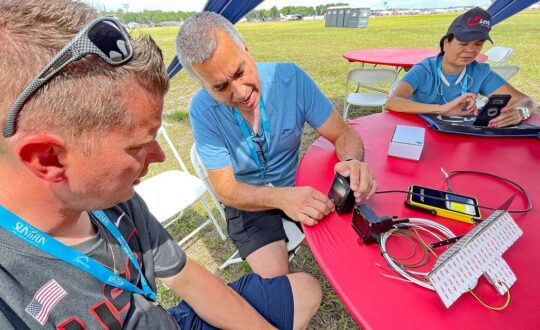
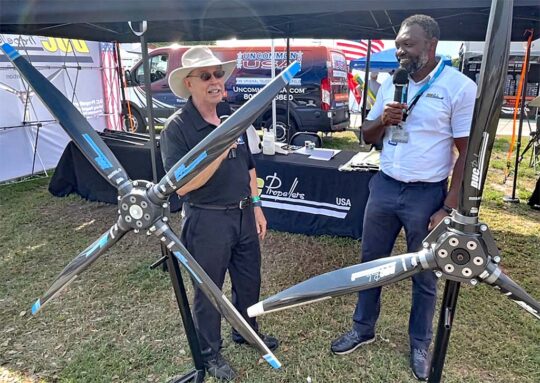 Duc Prop Success Story
Duc Prop Success Story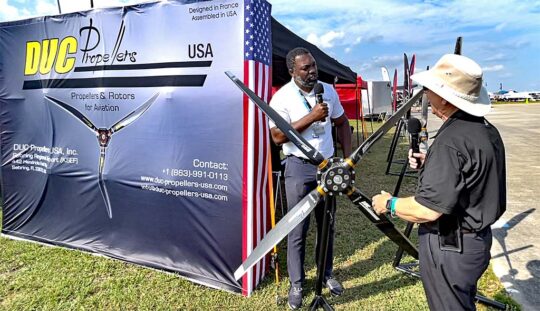 Of course, he is a sales and service outlet for Duc Hélices. Manufacturing occurs in Frontenas, France. According to Gaetan, the French enterprise is humming at its still-new
Of course, he is a sales and service outlet for Duc Hélices. Manufacturing occurs in Frontenas, France. According to Gaetan, the French enterprise is humming at its still-new 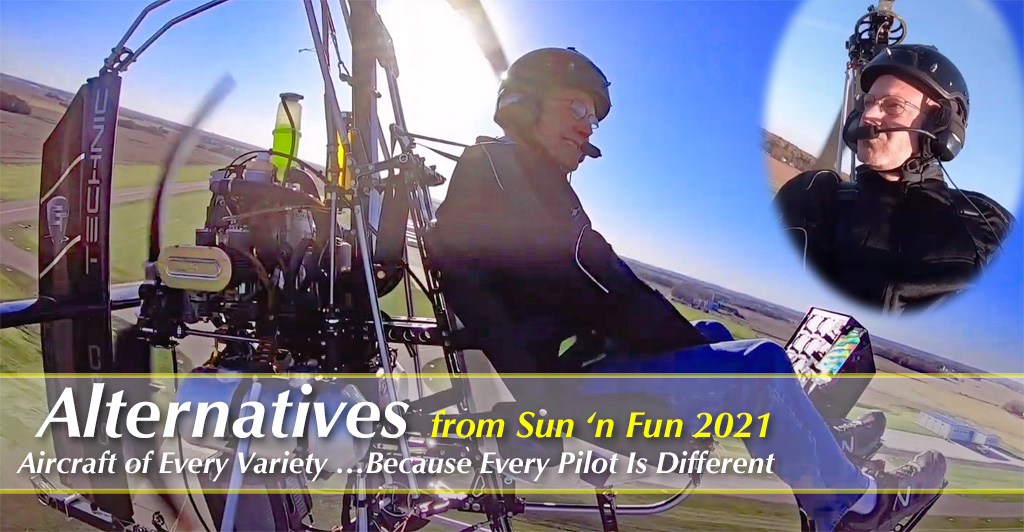
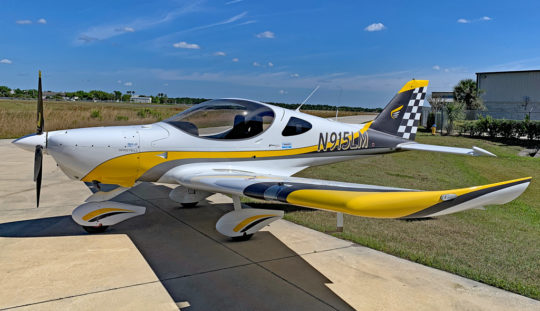 Other than the pure thrill of logging a high groundspeed, going fast is only useful when you're going somewhere. If perhaps your goal is aerial sightseeing then slow (and probably low) is the way to go. If you have to go fast, remember that old saying from auto racing: "Speed cost money; how fast do you want to go?" This equally applies to aviation.
FAA actually drew a speed line back in the early 2000s when the SP/LSA rule was being written (just as now with the LSA 2023 rule in the works). No, I don't refer to the 120-knot speed limit we'll discuss below. I refer to a slower speed, the one implied in the minimum 20 hours required for a Sport Pilot certificate.
Other than the pure thrill of logging a high groundspeed, going fast is only useful when you're going somewhere. If perhaps your goal is aerial sightseeing then slow (and probably low) is the way to go. If you have to go fast, remember that old saying from auto racing: "Speed cost money; how fast do you want to go?" This equally applies to aviation.
FAA actually drew a speed line back in the early 2000s when the SP/LSA rule was being written (just as now with the LSA 2023 rule in the works). No, I don't refer to the 120-knot speed limit we'll discuss below. I refer to a slower speed, the one implied in the minimum 20 hours required for a Sport Pilot certificate.
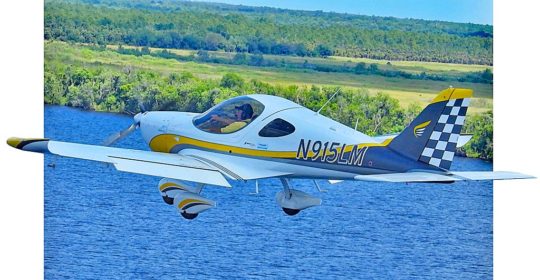 Rule writers separated Light-Sport Aircraft as sub-87 knot and faster. At the time the rule was released, this made sense. America was still flying lots of what we now loosely call "ultralights." These aircraft were simply built, half the empty weight of most LSA today, and flew slower, usually under 100 mph …87 knots.
Then LSA got glass cockpits, leather interiors, high performance engines, autopilots, and more. Prices went up accordingly and today we have a bifurcated market — just like FAA once envisioned, with simpler sub-87 knot airplanes and faster but more costly models.
Rule writers separated Light-Sport Aircraft as sub-87 knot and faster. At the time the rule was released, this made sense. America was still flying lots of what we now loosely call "ultralights." These aircraft were simply built, half the empty weight of most LSA today, and flew slower, usually under 100 mph …87 knots.
Then LSA got glass cockpits, leather interiors, high performance engines, autopilots, and more. Prices went up accordingly and today we have a bifurcated market — just like FAA once envisioned, with simpler sub-87 knot airplanes and faster but more costly models.
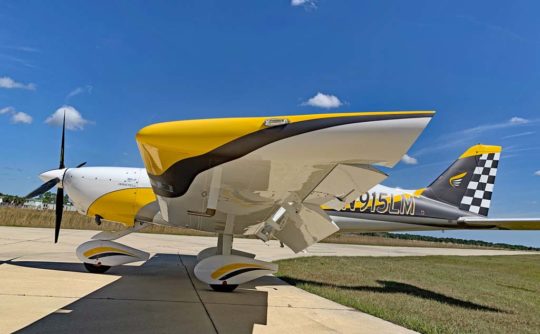 For plenty of pilots, 100 mph is fine for most of their flying including regional travel. Those who yearn for speed or want to travel interstate or cross country want the fastest machine they can afford.
The aircraft I've written about recently —
For plenty of pilots, 100 mph is fine for most of their flying including regional travel. Those who yearn for speed or want to travel interstate or cross country want the fastest machine they can afford.
The aircraft I've written about recently — 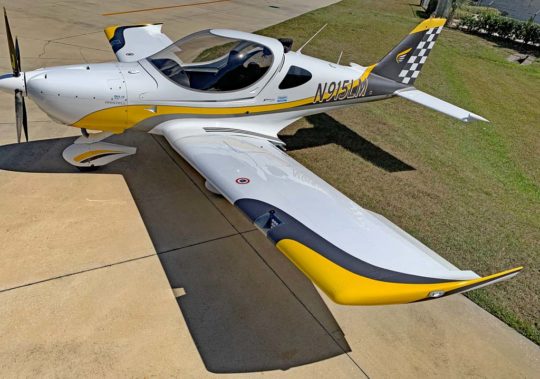 BRM Aero was early to begin work with Rotax's new
BRM Aero was early to begin work with Rotax's new 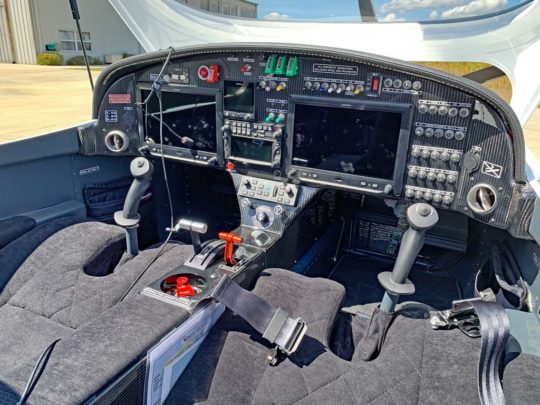 "Vne, Velocity Never Exceed, is an indicated air speed," Lou started in a reply to a Facebook audience. "For example, When the 915iS powered Bristell Speedster is flying at 12,500 feet with a true airspeed of 170 miles per hour or 147 knots, the indicated airspeed is only 118 knots. The Bristell has a 157 knots Vne." A good
"Vne, Velocity Never Exceed, is an indicated air speed," Lou started in a reply to a Facebook audience. "For example, When the 915iS powered Bristell Speedster is flying at 12,500 feet with a true airspeed of 170 miles per hour or 147 knots, the indicated airspeed is only 118 knots. The Bristell has a 157 knots Vne." A good 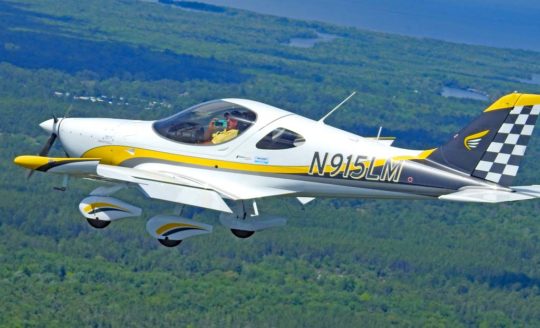
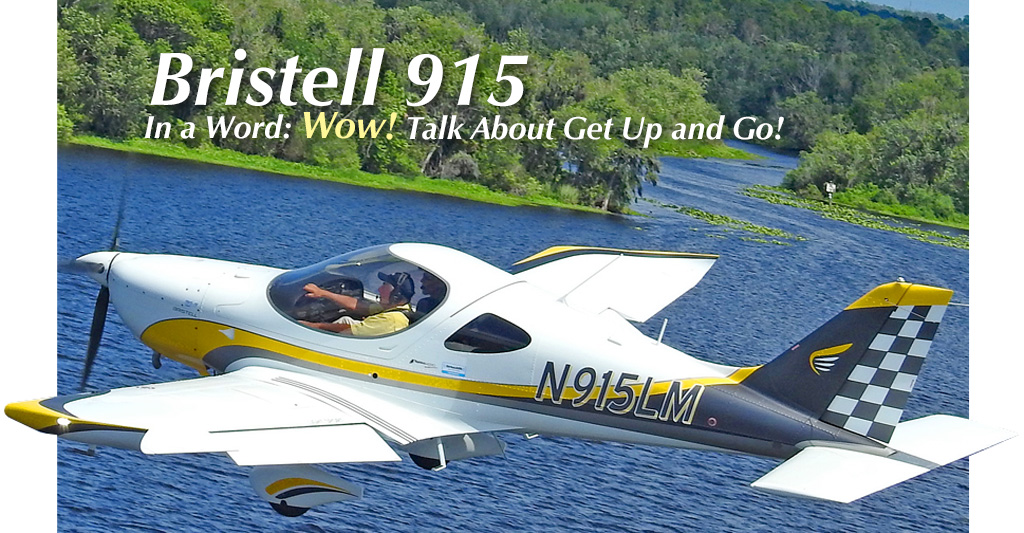
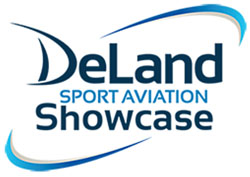 "The
"The 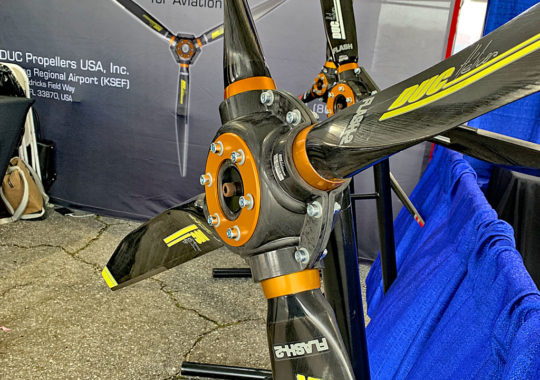 Visitors to the inside displays at Deland Showcase 2019 saw a new Flash 2 four-blade prop on display in the
Visitors to the inside displays at Deland Showcase 2019 saw a new Flash 2 four-blade prop on display in the 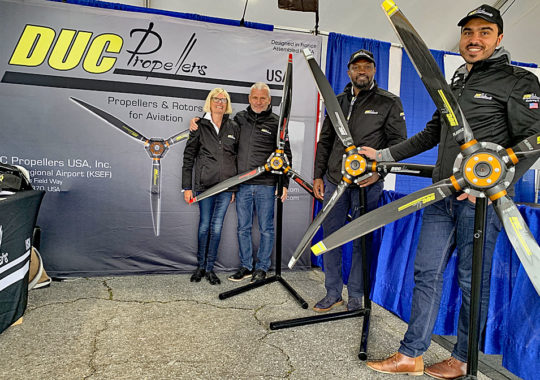
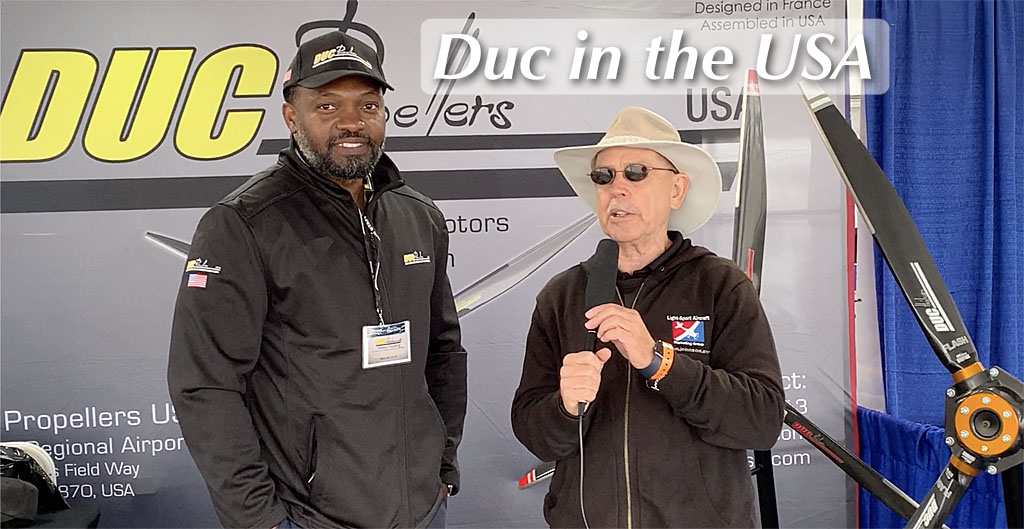
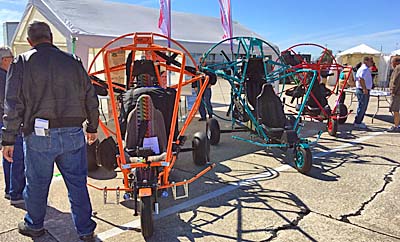
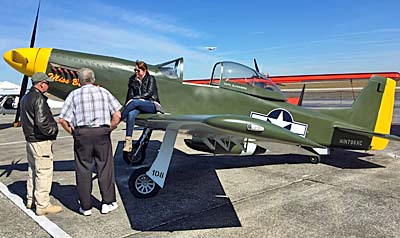
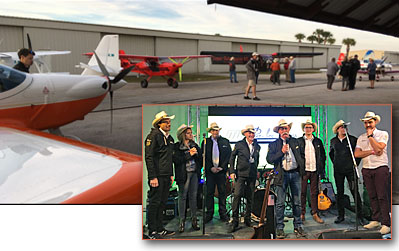
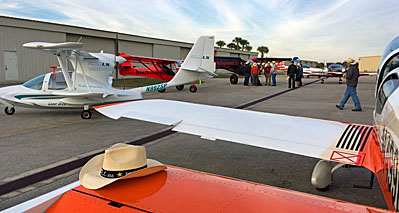
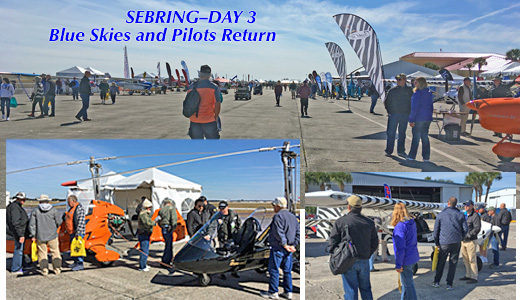
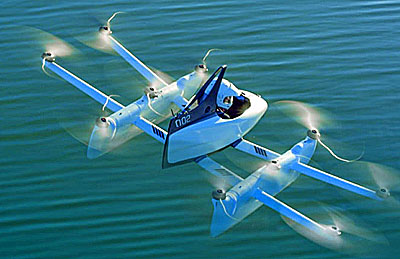 Imagine you are in charge of marketing for French propeller manufacturer,
Imagine you are in charge of marketing for French propeller manufacturer, 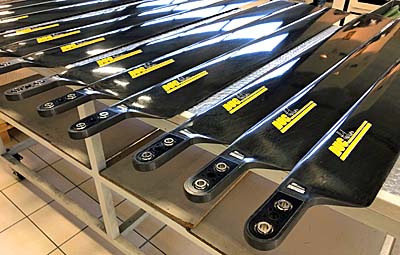 Those many breathless stories in mainstream media about autonomously flown air taxis may paint a very different, possibly exciting image of the future of flight, but they may also be years, or decades, away.
Vehicles like Kitty Hawk's Flyer could get to the market much sooner, assuming FAA throws up no roadblocks — I don't see the agency doing that, drones have registered more than a million units giving FAA extra duties but also knowledge, and leverage. Indeed, the drone/multicopter development must be music to the regulators' ears.
Multicopters are also music to ears of prop makers. While
Those many breathless stories in mainstream media about autonomously flown air taxis may paint a very different, possibly exciting image of the future of flight, but they may also be years, or decades, away.
Vehicles like Kitty Hawk's Flyer could get to the market much sooner, assuming FAA throws up no roadblocks — I don't see the agency doing that, drones have registered more than a million units giving FAA extra duties but also knowledge, and leverage. Indeed, the drone/multicopter development must be music to the regulators' ears.
Multicopters are also music to ears of prop makers. While 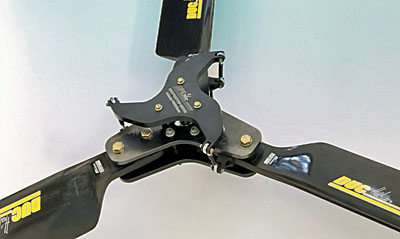 Last spring,
Last spring, 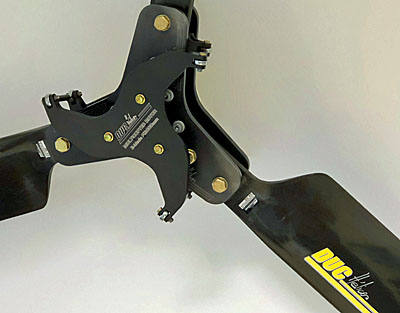 Duc Hélices has enjoyed considerable success in the U.S. market, thanks to persistent effort at airshows by their capable Michael Dederian. At LSA events these days, I see two brands all the time: Sensenich from Plant City, Florida and Duc Hélices from Frontenas, France.
To better serve their growing U.S.market, Duc will open a new facility at the Sebring, Florida airport. To celebrate, Duc Propellers USA will host an official opening party in Hangar C2 (442 Hendricks Field Way). People attending the event are invited at 6 PM on Friday January 25, 2019. To confirm or ask questions about the kick-off party, contact Mrs. Héloïse Jonda at her
Duc Hélices has enjoyed considerable success in the U.S. market, thanks to persistent effort at airshows by their capable Michael Dederian. At LSA events these days, I see two brands all the time: Sensenich from Plant City, Florida and Duc Hélices from Frontenas, France.
To better serve their growing U.S.market, Duc will open a new facility at the Sebring, Florida airport. To celebrate, Duc Propellers USA will host an official opening party in Hangar C2 (442 Hendricks Field Way). People attending the event are invited at 6 PM on Friday January 25, 2019. To confirm or ask questions about the kick-off party, contact Mrs. Héloïse Jonda at her 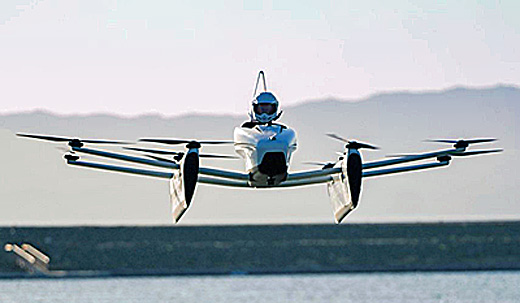
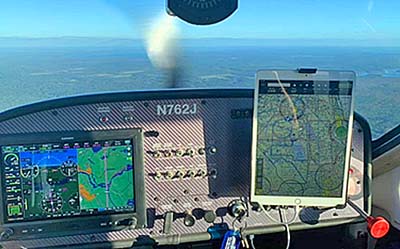
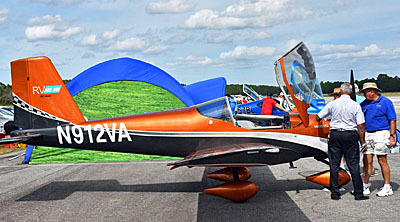
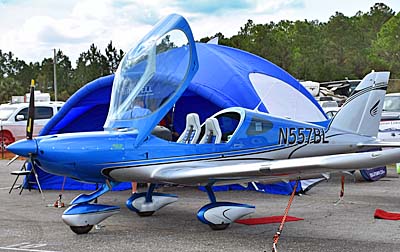
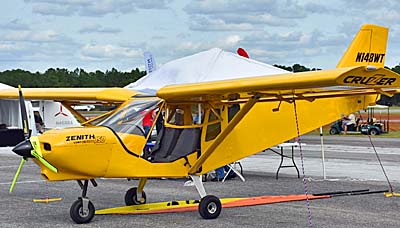
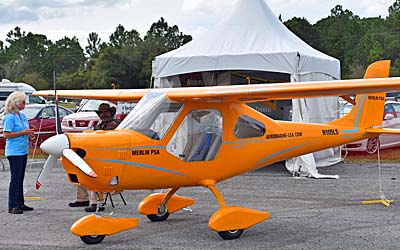
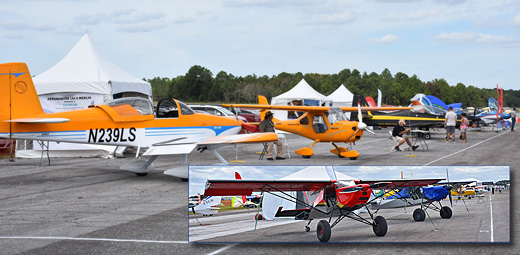
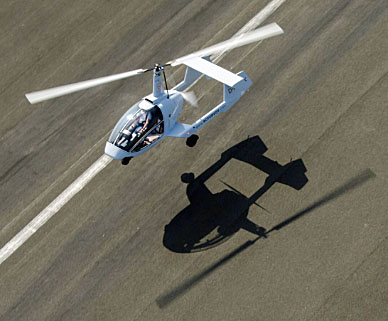 Besides LSA seaplanes, one area of furious development (and sales) is gyroplanes, the term modern industry prefers to "gyrocopter," which was actually a branded name used since the days of Igor Benson.
A new player, arriving on the scene about five years ago, is Rotorvox. Americans have not seen this aircraft but will soon get an opportunity at
Besides LSA seaplanes, one area of furious development (and sales) is gyroplanes, the term modern industry prefers to "gyrocopter," which was actually a branded name used since the days of Igor Benson.
A new player, arriving on the scene about five years ago, is Rotorvox. Americans have not seen this aircraft but will soon get an opportunity at 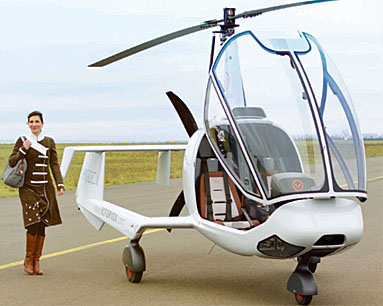
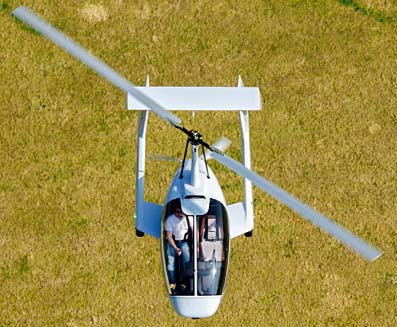 Rotorvox Aero will act as the U.S. importer and will display C2A in Lakeland from April 10
Rotorvox Aero will act as the U.S. importer and will display C2A in Lakeland from April 10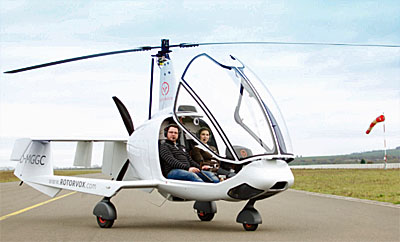 C2A is sold ready-to-fly in Europe but must be sold as an Experimental Amateur Built kit in the USA.
C2A is sold ready-to-fly in Europe but must be sold as an Experimental Amateur Built kit in the USA. 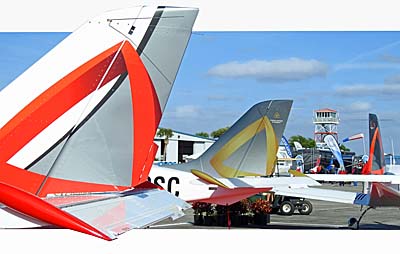 The fourteenth running of the
The fourteenth running of the 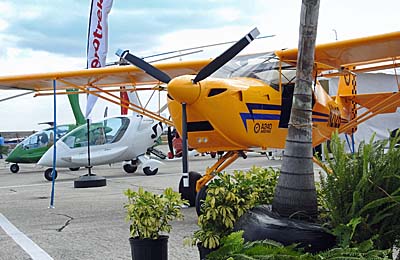
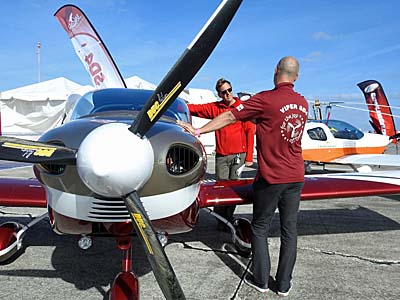
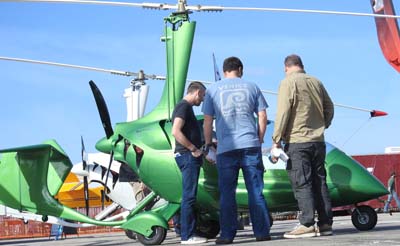
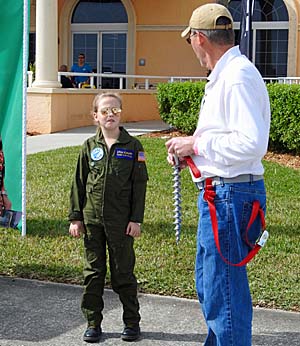
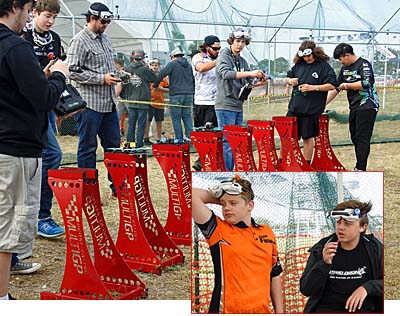
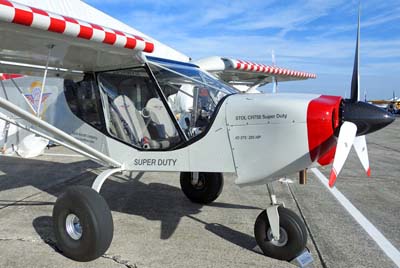 Day two of the year's first show, Sebring was a bit cooler and windier but still a fine day as the photos show. I would guess crowds were as good or better than yesterday not even counting a large contingent of ROTC candidates visiting for the day.
Day two of the year's first show, Sebring was a bit cooler and windier but still a fine day as the photos show. I would guess crowds were as good or better than yesterday not even counting a large contingent of ROTC candidates visiting for the day.
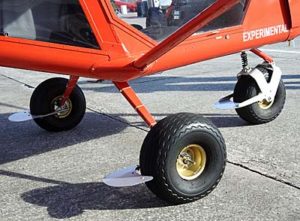 Aeroprakt USA displayed an A22LS model, the Ukraine design featuring vast expanses of clear plastic that deliver massive visibility. The show model had tundra tires with rather unique "footwear" as its tricycle gear used surfaces closer to fenders than wheel pants. They won't provide any drag reduction but will help keep mud or debris splatter off the wings and fuselage. The A-22 also had sliding windows useful for aerial photography.
Aeroprakt USA displayed an A22LS model, the Ukraine design featuring vast expanses of clear plastic that deliver massive visibility. The show model had tundra tires with rather unique "footwear" as its tricycle gear used surfaces closer to fenders than wheel pants. They won't provide any drag reduction but will help keep mud or debris splatter off the wings and fuselage. The A-22 also had sliding windows useful for aerial photography.
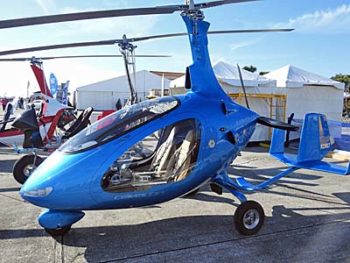 AutoGyro USA
AutoGyro USA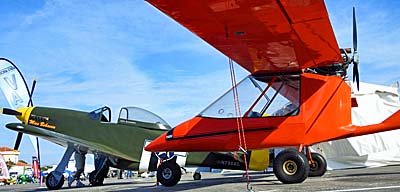 It was fun to get caught up with John Williams of
It was fun to get caught up with John Williams of 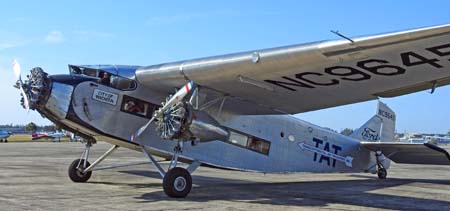
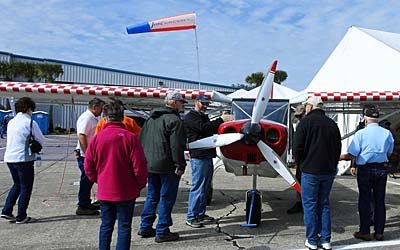
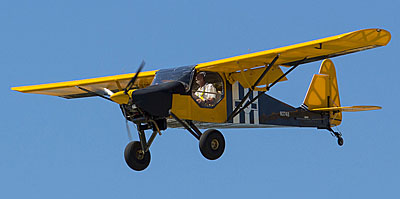 Belite entrepreneur James Weibe has successfully used his tech industry background to raise interest for his latest project, this time his first two seater called Chipper. (It was named Pipper but that apparently energized the anxieties of Piper Aircraft lawyers so James altered the name.)
James has informed his Facebook and email readers with continual updates. After making initial flights fairly recently, he has judged the aircraft able to make a cross country flight.
Chipper uses power from the 912
Belite entrepreneur James Weibe has successfully used his tech industry background to raise interest for his latest project, this time his first two seater called Chipper. (It was named Pipper but that apparently energized the anxieties of Piper Aircraft lawyers so James altered the name.)
James has informed his Facebook and email readers with continual updates. After making initial flights fairly recently, he has judged the aircraft able to make a cross country flight.
Chipper uses power from the 912 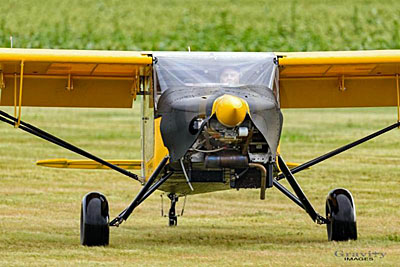 "I flew Chipper to Angel Fire, New Mexico," James exclaimed. "I flew nonstop one way (960 miles roundtrip) from Wichita, Kansas to Angel Fire, performed flight tests, and then returned to Marion, Kansas before the sunset." Now that's a good day's flying.
"Angel Fire is the fourth highest elevation airport in the United States at 8,322 feet above sea level," James reported. "Density altitude was 10,400 feet." Three conditions can degrade aircraft performance at altitude: higher elevation, higher temperature, and higher humidity. The latter is not much of a problem in desert-like New Mexico but all affect aircraft performance. (Humid air, made up of water vapor, is less also dense.)
In my experience, operating at more than 10,000 feet density altitude causes a Cessna 150 or 172 to take significantly more runway to get airborne and climb performance can be sharply reduced.
"I flew Chipper to Angel Fire, New Mexico," James exclaimed. "I flew nonstop one way (960 miles roundtrip) from Wichita, Kansas to Angel Fire, performed flight tests, and then returned to Marion, Kansas before the sunset." Now that's a good day's flying.
"Angel Fire is the fourth highest elevation airport in the United States at 8,322 feet above sea level," James reported. "Density altitude was 10,400 feet." Three conditions can degrade aircraft performance at altitude: higher elevation, higher temperature, and higher humidity. The latter is not much of a problem in desert-like New Mexico but all affect aircraft performance. (Humid air, made up of water vapor, is less also dense.)
In my experience, operating at more than 10,000 feet density altitude causes a Cessna 150 or 172 to take significantly more runway to get airborne and climb performance can be sharply reduced.
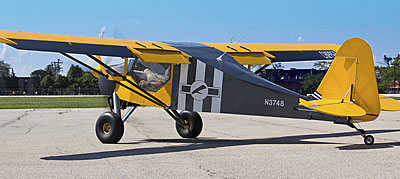 "Chipper's takeoff roll length was 600 feet," said a proud James. "Why did they make the runway 8,900 feet long at Angel Fire," James wondered with a twinkle in his eye?
"Climbout was greater than 200 fpm," he added. Now that's not nearly as fast as a 80-horsepower Chipper would perform at sea level but it's better than a Cessna 150. "Everything in the pattern was normal," James continued, "it just took longer to climb."
For his evaluation, Chipper's test weight was 950 pounds. He observed that a normally-aspirated (carbureted) 80-horsepower Rotax develops 52 horsepower at Angel Fire's pattern altitude.
"Chipper's takeoff roll length was 600 feet," said a proud James. "Why did they make the runway 8,900 feet long at Angel Fire," James wondered with a twinkle in his eye?
"Climbout was greater than 200 fpm," he added. Now that's not nearly as fast as a 80-horsepower Chipper would perform at sea level but it's better than a Cessna 150. "Everything in the pattern was normal," James continued, "it just took longer to climb."
For his evaluation, Chipper's test weight was 950 pounds. He observed that a normally-aspirated (carbureted) 80-horsepower Rotax develops 52 horsepower at Angel Fire's pattern altitude.
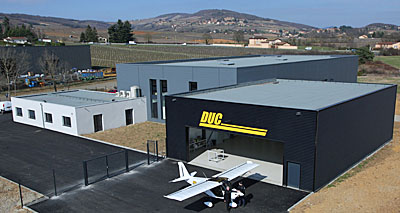
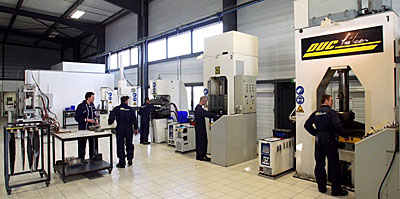 "Lot of guests will arrive all long the day by plane but the party will officially start at 8 p.m. with the visit of the new facilities, a photoBooth on flying topics, a Beaujolais culinary discovery, a cocktail dinner, a music DJ, and some animations throughout the night," said DUC representatives.
"Lot of guests will arrive all long the day by plane but the party will officially start at 8 p.m. with the visit of the new facilities, a photoBooth on flying topics, a Beaujolais culinary discovery, a cocktail dinner, a music DJ, and some animations throughout the night," said DUC representatives.
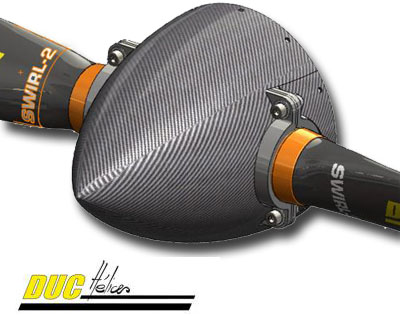 The good news is, DUC props are available in the USA thanks to
The good news is, DUC props are available in the USA thanks to 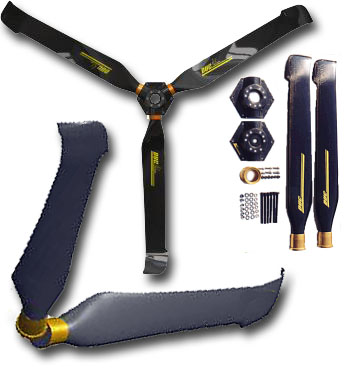 SportairUSA lists some of your choices in props from DUC.
Swirl (photo above) is a simple, ground-adjustable propeller that performs like a complex constant-speed prop. "It is the propeller of choice for faster airplanes," said SportairUSA. How can that be? "Without movement or twisting of the blades DUC's Swirl propeller has a constant speed effect… [because] the prop takes a slimmer bite under load, and a fatter bite when cruising, without the need for complex electro-mechanical adjustments."
Windspoon (lower photo) is for slower aircraft (speeds up to 80 knots for engines up to 120 horsepower). SportairUSA explained, "With its revolutionary shape [that] offers unrivaled performance, Windspoon is the ideal solution for trikes and similar aircraft."
For more detail including specifications and prop ordering information, visit SportairUSA's dedicated
SportairUSA lists some of your choices in props from DUC.
Swirl (photo above) is a simple, ground-adjustable propeller that performs like a complex constant-speed prop. "It is the propeller of choice for faster airplanes," said SportairUSA. How can that be? "Without movement or twisting of the blades DUC's Swirl propeller has a constant speed effect… [because] the prop takes a slimmer bite under load, and a fatter bite when cruising, without the need for complex electro-mechanical adjustments."
Windspoon (lower photo) is for slower aircraft (speeds up to 80 knots for engines up to 120 horsepower). SportairUSA explained, "With its revolutionary shape [that] offers unrivaled performance, Windspoon is the ideal solution for trikes and similar aircraft."
For more detail including specifications and prop ordering information, visit SportairUSA's dedicated 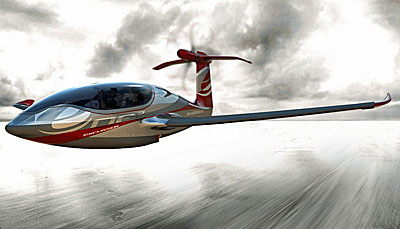 Now consider Equator Aircraft P2 Xcursion, an electric hybrid seaplane with several compelling ideas. I wrote about this in
Now consider Equator Aircraft P2 Xcursion, an electric hybrid seaplane with several compelling ideas. I wrote about this in 